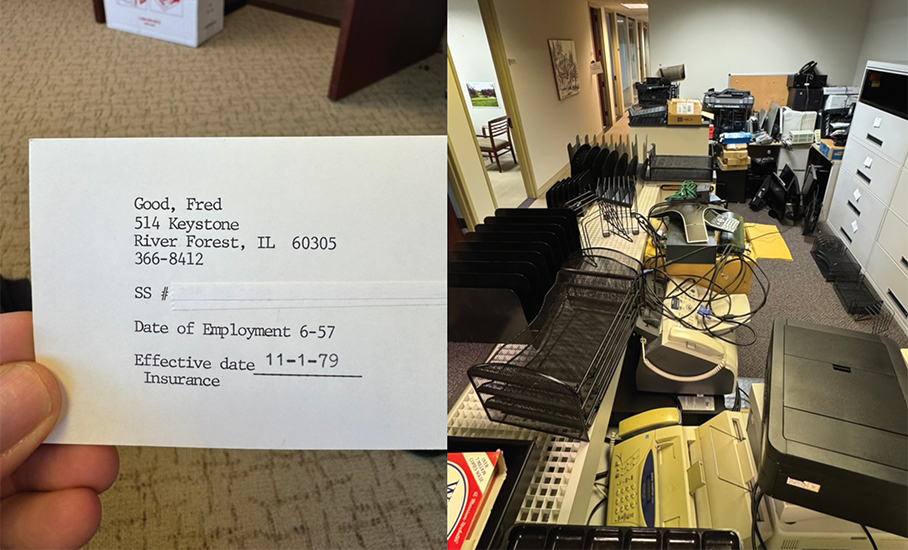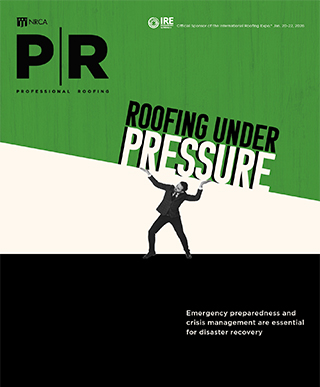
By the time you’re reading this, NRCA will have moved from its longtime headquarters in Rosemont, Ill., to a new office in Itasca, Ill.
NRCA had been in Rosemont for 36 years. Many reading this (and several NRCA staff members) weren’t even born when the association previously relocated. NRCA moved to Rosemont soon after the association’s 100-year anniversary, and the office served witness to a significant number of changes and transitions for the industry and the association.
When NRCA moved to Rosemont in 1989, Cher’s song “If I Could Turn Back Time” was playing on Top 40 radio stations and cassettes across the U.S. And turning back time is what this moving experience has been for NRCA staff.
Our old space was built for the needs and operations of the association during the 1990s. The world ran on paper back then. And NRCA was equipped for it. We had paper, files, physical records and storage. So much storage: Eighty five-drawer filing cabinets spread across nearly 23,000 square feet. And that’s not counting the two-drawer mini filing cabinets that lived under each desk and cube. Now, many of our systems are in the cloud accessible by staff anywhere.
We also had more than 100 bookcases measuring 6 feet high with five or more shelves. These held everything from old educational class materials to staff memos and records. Vital information and trivial items alike, NRCA kept its stuff.
I’m guessing there are many contractor warehouses in similar shape. If you have the space, things just accumulate. A tool, machinery or item that was put there at some point and forgotten. If something is not on anyone’s radar, nobody wants to get rid of the item because “It was put there by someone for a purpose, but I know it’s not mine and I’m not going to risk getting rid of it!”
But about a year or so ago, each NRCA department began asking: “Who does this belong to, and do we need it?” They went through every shelf, file drawer and cabinet with a lens of whether something was physically important and needed to be kept, digitized or thrown away.
The NRCA of 2025 stands on the shoulders of those who did the work for us and the industry years or decades earlier
Much was out of date, irrelevant or trivial like a fax confirmation of an office party pizza order from more than a decade ago. We found Betamax players, slide projectors, a few typewriters, a dictaphone, microcassette recorders, cameras, laptops that weighed several pounds and reels of 16-mm film that held the footage for “Right on Roofing.” We found a CPR mannequin on the top back corner of a shelf in our storage area. We found boxes labeled “Education materials. Do not touch!” But the team would look through the boxes briefly and toss all of them in the trash bin.
Many other items were relevant and historically significant. For example, it was fascinating looking through records of NRCA’s effort to successfully donate the roof to the Pentagon following the 9/11 attacks. Having and preserving that history is important.
Two of the more amazing discoveries during this relocation project were:
- A time capsule nobody remembered or knew about. We haven’t opened it as of this writing, but the curiosity of what is in it is palpable.
- The personnel record of my predecessor’s predecessor’s predecessor. When the record was written, Fred Good had recently retired from full-time work with the association but still was engaged with the organization and industry. Our staff found his record typed on a note-card, possibly using one of the found typewriters.
Our technical staff scanned pallets and pallets of articles, books, installation guidelines, etc., that had lived in our technical library for years. The materials have been helpful for our staff, but in the coming months those resources will be added to NRCA’s online technical library so the entire industry can access them.
We had space for call centers in our office because the phone and physical mail were the primary means of communication. Members needed to call or write us for virtually all their needs. In 1990, there were 5 million fax machines in the U.S. We unplugged our fax machine a few months ago.
Because the way we do business has changed, our new space is about 10,000 square feet smaller than our old office. But leaving the old space was physically and emotionally demanding on staff. Many grew up there. The walls in Rosemont witnessed marriages, births, deaths, divorces, graduations and scandals. Members joined, rose through the ranks to association leadership, retired and passed away.
Our previous office space was home during the initiation of single-ply and the shattering of unreinforced membranes, asphalt fumes litigation, asbestos and silica studies. It also saw the creation of a position called a safety director and concepts like fall protection.
It was home during the birth of NRCA’s CERTA program, the Future Executives Institute and the modern NRCA technical manual. The Roofing Alliance formed within those old walls, and dozens and dozens of industry leaders met in its conference rooms. The space had been the setting for a great deal of change, and, in many ways, it’s part of NRCA. Similar to how the Seattle Seahawks fans are known as the 12th man on the team, so, too, is this office part of the team for many.
The NRCA of 2025 stands on the shoulders of those who did the work for us and the industry years or decades earlier. And while the association downsizes and shifts into a space more suited to its needs and output, we bring with us the legacy of those who pushed us to where we are today and the responsibility to continue to build on that work. To paraphrase my wife when I started this role: “NRCA has been around since 1886; don’t screw it up.”
Although we are trading our 12th man for a rookie, we will do our best to play the game and perform better than ever. Because that’s what our long history expects from us and what we expect from those who will follow.

McKay Daniels
CEO
NRCA



